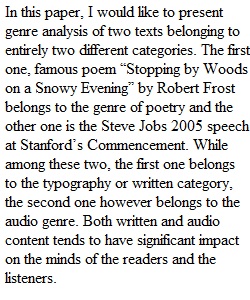


Q For the next three to four weeks, you will be working on the research component of Module #3 and Module #4. The purpose is to spread out these sections to make the research and writing more manageable. This week you begin developing your scaffolding Critical Annotated Bibliography CAB Assignment for Module 4: Broader Community Study: “The broader community study will build upon students’ local research, extending it into a broader inquiry. Students have the option to change their focus. This project will incorporate secondary research in order to examine the societal impact of their chosen issue. This includes developing a larger list of sources and creating an evaluative annotated bibliography” As a reminder, one of the methods/ methodology for gathering primary research is the use of developing a survey using Survey Monkey software. You will use Survey Monkey as your research component. The peer-review for the CAB will begin next week. Aim to have at least six sources for the CAB. You need at least ten sources for the Broader Community Study. Review APA style for in-text citation: short quotes (aka direct quotes), long quotes (aka block quotes), summarizing and paraphrasing information. Also, review how to cite sources in the Reference page. Most people do not think they will ever have to use a Critical Annotated Bibliography. The following video provides a professional example of how a CAB is used to create a discussion on the needs of a community. Watch the video proceeding under Web Resources: A Public Discussion of Literature Review of Research on Critical Needs….. https://www.youtube.com/watch?v=13h4sB9lYMk ________________________________________ This week begin and complete the scaffolding for your primary research. Read below the information. Scaffolding: Primary Research: Survey Questions created in Survey Monkey (Submit your survey and wait for classmates to take your survey) Part of the Primary Research collection is in the form of an online survey in which you will post under a discussion thread so that everyone in the class can take your survey to collect your Primary Research. There are 25 students in the class, so you should have a good pool of answers. You will create ten survey questions in Survey Monkey. You may have nine closed-ended questions (such as multiple choice, true/false, etc…) and one open-end question (short response). The nine closed-ended questions, Survey Monkey will collate for you; however, the one-open ended question, Survey Monkey will collect the responses, but it is up to you to read through them and use what is useful to your research. Use the free version https://www.surveymonkey.com/ If you have never used Survey Monkey here is quick tutorial that covers the basics. Survey Monkey Tutorial: https://www.youtube.com/watch?v=e2qG14YX5O4 ________________________________________ Readings: EAA Reader: Review Course Calendar for EEA Chapter Readings & FYC Handbook. ***Note: As a reminder, you are responsible for reading these chapters, even though they will not always appear in a reader response discussion or reflection). FYC Handbook: Review Module #3 and Module #4 prompts. Module #3: Local Fieldwork: Students will identify a social, political, or ethical issue related to their local community or partnering agency. As part of this assignment students will generate research questions pertaining to the topic and their inquiry. Local research may include field observations, consulting local and primary sources, collecting surveys, and conducting interviews. Module #4: Broader Community Study: The broader community study will build upon students’ local research, extending it into a broader inquiry. Students have the option to change their focus. This project will incorporate secondary research in order to examine the societal impact of their chosen issue. This includes developing a larger list of sources and creating an evaluative annotated bibliography. Additional Reading Material: Folder on Critical Annotated Bibliography and its PDF documents. Documents to review: Developing good research questions. Using the MEAL Plan to develop your CAB. Guidelines to the CAB scaffolding assignment and student example. As a reminder, go back and read the information provided under week three and four about creating surveys. ________________________________________ Things to think about: • The use of Primary Research to develop an issue; • The use of research questions to help create an inquiry on the issue; • The use of secondary research to expand the research; • The use of a Critical Annotated Bibliography (CAB) to collect research data ________________________________________ Work in Progress: • Begin working on your Survey Questions you may begin posting- the discussion link is open to upload your survey when you are ready. Make sure you can open the survey. Test it out within the discussion link and take the survey yourself. (Discussion Link Open to Upload survey). • Peer-Review #2 CAB (due at the end of week six) • Reflection Research Journal (RRJ) Discussion Thread #2 (due week six) ________________________________________ DUE: Peer-Review #2: (CAB1), with sentence outline: For consulting local and primary sources DUE: Reader Response Discussion #5 (complete at the end of week five) Due: (RRJ) Discussion Thread #2 DUE: Survey Questions Posted DUE:Community Genre Analysis Final
View Related Questions